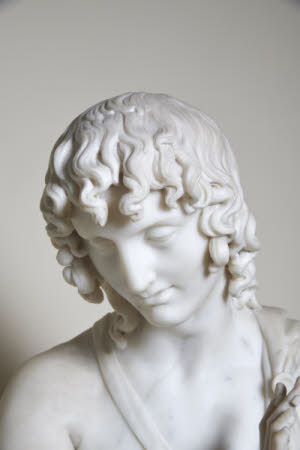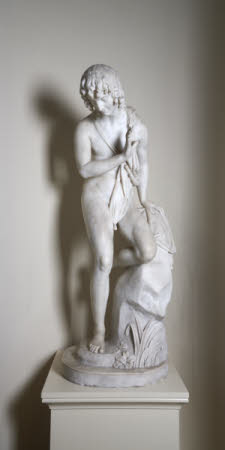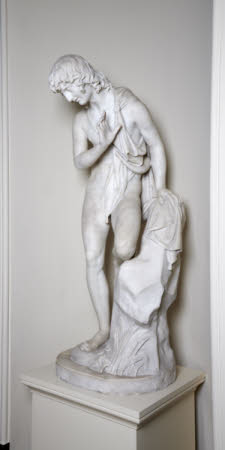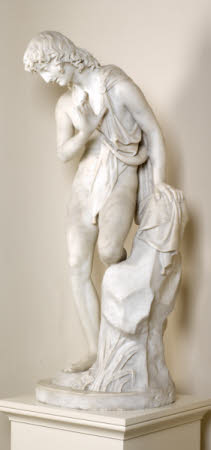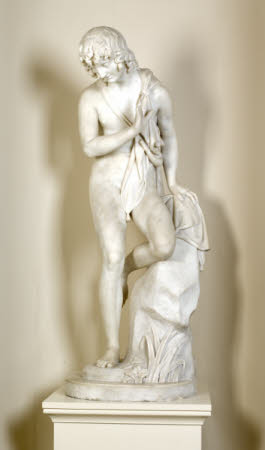Narcissus admiring his Reflection
attributed to Italian (Florentine) School
Category
Art / Sculpture
Date
c. 1825 - 1850
Materials
Marble
Measurements
1562 x 690 x 530 mm
Place of origin
Italy
Order this imageCollection
Mount Stewart, County Down
NT 1542339
Summary
Sculpture, marble; Narcissus; Italian, Florentine ; c. 1825-50. A figure of Narcissus, the Greek youth who fell in love with his own reflectionand who pined away and was turned into the narcissus flower. Probably, but not certainly, made by a sculptor working in Florence.
Full description
A marble statue of Narcissus, shown as he sees for the first time his reflection in water and begins to fall in love with it. Narcissus is shown standing, his left leg propped on a rocky outcrop, on which he also leans, his right hand raised in a gesture of surprise as he catches sight of his reflection. He is depicted as a slim and rather effeminate youth, with hair that falls in beautiful long curls around his face; he is naked, except for a drapery fastened at his left shoulder with a brooch and with tassels at its ends. Some of this drapery also covers the top of the rock. Narcissus also has a hunting horn on a strap, slung over his right shoulder. The base is rectangular with curved corners. Around his feet at the base is aquatic vegetation, including water reeds and lilies. Two finhgers of the left hand are broken off. The tragic story of Narcissus and Echo is told by the Roman poet Ovid in his Metamorphoses (3: 339-510). The nymph Echo, who loved the handsome youth Narcissus, was punished by the goddess Juno, who condemned her to repeat only the last words that were spoken to her. Meanwhile Narcissus, as a punishment for spurning Echo, was made to fall in love with his own reflection in a stream. He pined away gazing at himself, on his death being transformed into the flower known as narcissus, which thereafter became a symbol of youthful death. Echo also wasted away in her sad sorrow, until nothing remained of her but her voice. The myth of Narcissus would have had a special resonance for the ancient Greeks, who believed that a man’s soul was contained within his reflection, so that to dream of it became an omen of death. The subject of Narcissus had long been popular in Florentine art, from Benvenuto Cellini’s figure of the youth, which was begun for Grand Duke Cosimo I de’Medici in 1548, but was still in the sculptor’s studio uncompleted, on his death in 1870. It was subsequently placed in the Boboli gardens in Florence before being moved to the Museo Nazionale del Bargello. The Narcissus is one of a group of sculptures formerly at Wynyard Park, the Londonderry house in Co. Durham, and now on loan to Mount Stewart. It has formerly been attributed to Lorenzo Bartolini (1777-1850), from whom the third Marquess of Londonderry commissioned several sculptures, the first when he and his wife and son spent several weeks in Florence early in 1823. They include the important standing figure of Frances Anne, Marchioness of Londonderry and her son, George William Vane-Tempest, Viscount Seaham, who would eventually become the 5th marquess of Londonderry (NT 1542334). The Narcissus seems very unlikely to be the work of Bartolini however. The relatively comprehensive contemporary lists of Bartolini’s works only mention a single figure of Narcissus, whilst also stating clearly that it was never executed in marble. The sculptor’s original gesso (plaster) model survives with other models from his studio in the Galleria dell’Accademia in Florence (Inv. 1218). It is in fact quite unlike the present sculpture, which also does not reflect Lorenzo Bartolini’s style. It is nevertheless probably Florentine, the work of another sculptor working in the city in the second quarter of the nineteenth century, although there seems also in Britain in the 1820s and 1830s to have been a short-lived fashion among sculptors for the subject. Sculptures of Narcissus were exhibited at the Royal Academy in 1822 and 1823 (1822, no. 1031, clay model; 1823, no. 1131, marble) by Edward Gustavus Physick (1802-75), in 1825 (no. 1050) by William Scoular (1796-1854) and in 1838 (no. 1255) by John Gibson (1790-1866), the latter now in the collection of the Royal Academy. It is not known what the sculptures by Physick and Scoular looked like. Jeremy Warren September 2022
Provenance
Wynyard Park; on loan from the Estate of the Marquess of Londonderry
Credit line
Estate of the Marquess of Londonderry
Makers and roles
attributed to Italian (Florentine) School, sculptor attributed to Lorenzo Bartolini (Vernio, Tuscany 1777 – Florence 1850), sculptor
References
Wynyard 1949: Inventory and Valuation of the Contents of Wynyard Park, Co. Durham, the property of the Most Honourable the Marquess of Londonderry… deceased. Prepared for the purpose of probate by H. Clifford-Smith. 1949, p. 34, Statue Hall.

